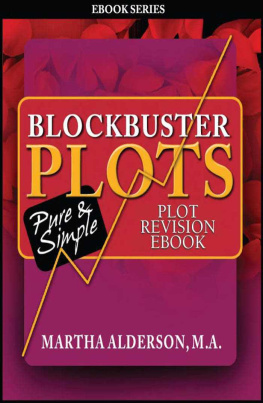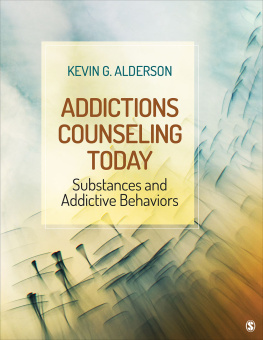
BLOCKBUSTER PLOTS
Before the Next Draft;
Push aside the Words to Reveal the
Deeper Plot & Structure of Your Story
By:
Martha Alderson
Copyright 2010 Martha Alderson
All rights reserved. No part of this book may be reproduced in any form or by any means, electronic or mechanical, including photocopying, recording, or by any information storage and retrieval system, without permission in writing from the author: .
ISBN 978-0-9790596-2-3
Published by:
Illusion Press
PO Box 1402
Capitola, CA 95010
www.illusionpress.com
First Edition 2010
CONTENTS
Writer by night, by day I help other writers achieve their dreams of completing a novel, memoir, or screenplay. My clients include best-selling authors, New York editors, and Hollywood movie directors.
As the Plot Whisperer, I listen to writers recount the scenes and events, ideas and frustrations around their stories. Using what I know from working with thousands of writers and analyzing thousands of classic and contemporary novels, memoirs, and screenplays, I whisper plot parameters, offer tips on theme and nuance, rhythm and depth, tricks for layering and pacing, all with the hope of reawakening in writers the universal story form.
Stories reflect the heartbeat of the universe. Writers and readers, all of us, pulse in time to this universal rhythm. I practice with the belief that the more integrated plot in writers' bodies and story structure in reader's psyches, the more satisfying the act of writing and joyful the act of reading.
I wrote Before the Next Draft eBook for writers with a completed draft of a novel, chapter book, memoir, or screenplay who long to craft their project into a coherent story worthy of readers and an audiences appreciation.
My hope is that the following exploration of universal truths inspires you and your writing.
Writers who successfully write a story in only one draft are rare. Of these, only a few of the stories are published. Fewer writers accomplish the feat more than once.
The rest of us write in drafts, one at a time and often writing one plotline at a time. Some writers begin with the character emotional development. Others write the dramatic action plot. The plotline you choose to carry through the entire first draft is most often directly tied to your strength, and strength often determines preference.
A second draft is like overs in a game you think you may have already lost. The third draft represents a chance to delve more deeply into theme and meaning. Forth and fifth rewrites provide the space to tease out the more profound nuances of character and emotion.
Each time you write your story all the way through from beginning to end counts as one draft. After writing one complete draft and before embarking on the next, all writers benefit from a bit of periodic organization.
The process of re-visioning a story tends to involve tasks that are analytical and linear. To offset the plot and structure this eBook demands and to inspire your search for the storys deeper meaning, bits of Native American lore are included. In honor of the creative process, an exploration into the metaphysics of being a writer is thrown in, too.
In late 2007, short story writer, Mary Kennedy Eastham, author of The Shadow of a Dog I Cant Forget urged me to step forward. She had just completed her first attempt at National Novel Writing Month (NaNo). Having used my book, Blockbuster Plots Pure & Simple (BBP) to pre-plot the novel she wrote that November, she was now more convinced than ever that I, or more precisely the Plot Whisperer, was the answer to the question more than half the writers who annually complete NaNo are left wondering, Now what?
Those of you not familiar with the international writers sensation, NaNo is an annual novel writing project that brings together professional and novice writes from all over the world. Those of you who are familiar with NaNoWriMo know the event takes place every year in November. That International Plot Writing Month (PlotWriMo) runs during December, following NaNos month in November is no coincidence.
Ever passionate about supporting writers in the act of creation, I proclaimed December 2008 as the 1 st Annual PlotWriMo. My gift to writers, for the entire month of December, I offered on http://plotwhisperer.blogspot.com/ tailor-made for the busiest month of the year, 26 PLOT STEPS to answer writers with one draft who ask, what next?
When December 2009 rolled around, I showed up again at http://plotwhisperer.blogspot.com/ for the 2 nd Annual International PlotWriMo.
What: Craft a draft of your writing into a plot in one months time. No writing required.
Who: Anyone who has written a draft of a novel, memoir, or screenplay and is now ready to craft the project into a coherent piece worthy of publication.
Why: The first draft of any writing project is considered the generative phase. The muse is often responsible for much of the generative phase. The writer acts as a conduit and allows the inspiration to come through onto the page. The generative phase is all about getting the words on the page.
At the end of the generative phase, a writer is often faced with a manuscript full of holes and missteps, confusion and chaos. This is part of the process in that editing in the generative phase risks stifling the muse, which often results in stagnation.
When a writer completes the generative phase the real work beginscrafting the words into a coherent story. This is where PlotWriMo comes in.
Many writers, when left with pages and pages of words, are often at a loss about what to do next. Rather than shove words about on the page, take 26 PLOT STEPS to craft what you have into a viable story.
When: PlotWriMo begins December 1 st . Visit: http://plotwhisperer.blogspot.com/ daily throughout December for step-by-step guidance to prepare your manuscript for draft two. PlotWriMo ends December 31 st .
Where: Plot Whisperer blog: http://plotwhisperer.blogspot.com/ for everyday tips and tricks and inspiration throughout the month of December.
The idea for Before the Next Draft eBook emerged from the first two years of International Plot Writing Month.
Whether you have finished a rough, 1 st draft or what you hope is the final draft, for now, let your words rest and consider the overall structure and plot of your story.
Stand back
Analyze what you have
No writing required
Brainstorm for an effortless rewrite
Take the following 26 PLOT STEPS for deeper appreciation of what your story is truly trying to say. Then, and only then, dive back into the words and start rewriting.
You have completed a draft or more of a novel, memoir, or screenplay. Congratulations! You accomplished what many writers merely talk about and dream of doing you have written an entire story from beginning to end. Celebrate!
Now is time to craft the project into a coherent piece worthy of readers and an audience.
Two Caveats
1) Do NOT show anyone what you have written so far.
The first draft of any writing project is considered the generative phase. At the end of the generative phase, a writer is often faced with a manuscript full of holes and missteps, confusion and chaos. This is part of the process in that editing and/or an unbridled internal critic in the generative phase risks stifling the muse, which often results in stagnation.
Your first draft is a fragile thread of a dream. You know what you want to convey, well, maybe and sort of. Few writers can adequately communicate a complete vision in the first draft of a story, especially when writing by the seat of your pants. Allow others to read your writing now and you risk losing energy for your story and becoming overwhelmed by the task ahead of you.
Next page














